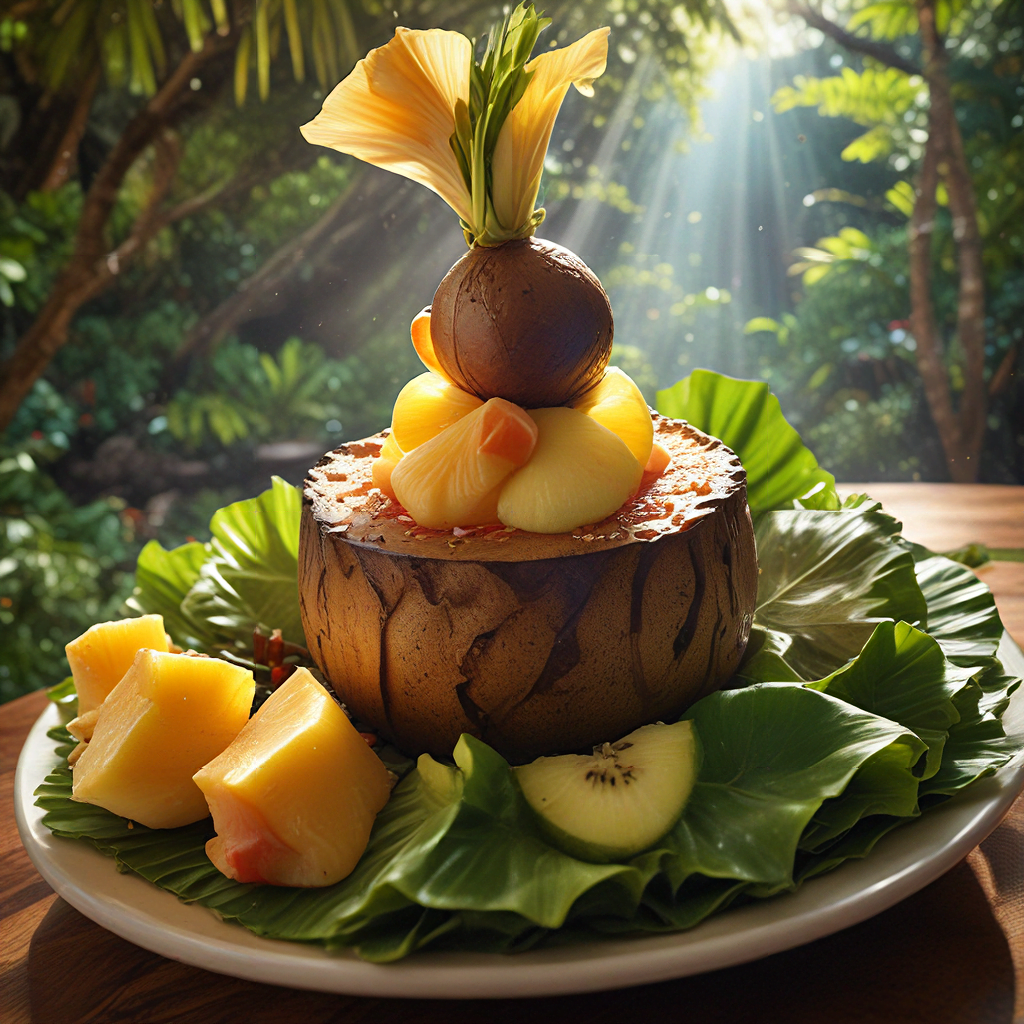Poi: A Culinary and Cultural Staple
Poi is a staple food in Hawaiian cuisine and a symbol of Hawaiian culture. It is made from the root of the taro plant, which is a starchy root vegetable that grows in wet, tropical climates. The taro root is peeled, cooked, and then pounded into a smooth paste. The paste is then fermented, which gives it a slightly sour flavor and a creamy texture. Poi is typically served as a side dish with other Hawaiian foods, such as kalua pig, lomi salmon, and chicken long rice.
Poi is a nutrient-rich food that is a good source of carbohydrates, fiber, and vitamins. It is also a good source of potassium, which is important for maintaining healthy blood pressure. Poi is a versatile food that can be eaten in many different ways. It can be eaten plain, or it can be used as an ingredient in other dishes. It can also be used to make desserts and other snacks.
The Mythological Origins of Poi
In Hawaiian mythology, poi is believed to be a gift from the gods. There are several stories that explain the origin of poi. One story tells of the god Kū, who was responsible for agriculture. Kū was so generous that he created a new plant for the people to eat. This plant was the taro plant, which would become the basis for poi.
Another story tells of the goddess Hina, who was the wife of the god Maui. Hina was a skilled weaver and she used to make clothing from the fibers of the taro plant. One day, Hina was weaving when she noticed that the taro leaves were wilting. She realized that the plants needed more water. Hina then went to the ocean and brought back a large amount of seawater to water the taro plants. The seawater made the taro plants grow even larger, and the roots became thicker and more flavorful.
Kū, the God of Agriculture and Poi
Kū, one of the most important gods in Hawaiian mythology, is often associated with agriculture and the taro plant. He is believed to have taught the Hawaiians how to cultivate the taro plant and make poi. Kū is depicted as a powerful and benevolent god who protects the land and its people.
Kū is often portrayed as a handsome man with a strong build and a determined expression. He is usually seen carrying a digging stick, which is used to cultivate the land. He is also often portrayed with a lei of taro leaves, representing his role in agriculture and poi.
In many Hawaiian legends, Kū is credited with creating the islands themselves. He is said to have used his digging stick to separate the islands from the ocean floor. He is also said to have created the fertile soil and the vast stretches of land that would support the Hawaiian people.
The Legend of the Poi Plant: A Gift from the Gods
In Polynesian cultures, the taro plant is considered to be sacred and is deeply connected to the gods. The origin story of the taro plant varies depending on the specific island and cultural group. However, a common theme in these stories is that the taro plant is a gift from the gods, given to the people as a source of food and sustenance.
One legend, common in Hawaii, tells of the goddess Haumea, who was known for her incredible power and fertility. She was also believed to have created the islands of Hawaii. Haumea once traveled to a faraway land, where she discovered the taro plant. She was so impressed by its ability to grow in wet and harsh conditions that she brought it back to Hawaii and shared it with the people. As a result, the taro plant became a symbol of Haumea's generosity and her commitment to the well-being of her people.
Poi: A Symbol of Strength and Endurance
In Hawaiian culture, poi is not just a food—it is a symbol of strength and endurance. The process of making poi is a laborious one, requiring time, effort, and patience. The taro root must be peeled and cooked, then pounded for hours until it reaches the desired consistency. This process reflects the strength and resilience of the Hawaiian people, who have endured countless challenges over the centuries.
Poi is a high-energy food that is ideal for sustained physical activity. It was traditionally eaten by the Hawaiian people as a source of fuel for their daily work, such as farming and fishing. It was also consumed by warriors before battle, to give them the energy and stamina they needed to fight.
The connection between poi and strength is evident in the way it is served and consumed. Poi is often eaten with the hands, showing a direct connection to the food and the process of its creation. The act of eating poi is seen as a ritual, a way of honoring the ancestors and the land that provides sustenance.
The Significance of Poi in Hawaiian Feasting
Poi is an essential part of Hawaiian traditional meals and feasts, known as "lu'au." It is typically served in a large communal bowl, representing the importance of community and sharing within Hawaiian culture. Poi is often paired with various Hawaiian dishes like “kalua pig” (slow-roasted pork), lomi salmon (diced salmon with tomatoes and onions), and chicken long rice. Its creamy texture and slightly tangy flavor complement the richness of these dishes.
In Hawaiian feasts, the presence of poi symbolizes abundance, prosperity, and the deep connection between the people and their land. The act of sharing poi among guests is a gesture of hospitality, respect, and honoring the ancestors who cultivated the taro plant. It signifies the importance of community, collaboration, and the shared heritage of the Hawaiian people. The presence of poi on the table is a reminder of the importance of preserving traditions and honoring their cultural roots.
Poi and the Hawaiian Identity
Poi is deeply ingrained in the Hawaiian identity, reflecting the history, culture, and values of the Hawaiian people. It serves as a reminder of their ancestral roots, their connection to the land, and their resilience in the face of adversity. Eating poi is a way of honoring the gods, the ancestors, and the hard work that goes into cultivating the taro plant.
The taro plant has been a source of life for the Hawaiian people for centuries. It was their primary food source and was used to create clothing, medicine, and other essential items. It was also used in various ceremonies and rituals. The taro plant represented the very essence of Hawaiian life and culture.
Today, poi continues to be a beloved food and a powerful symbol of Hawaiian identity. It is a reminder of the enduring strength and spirit of the Hawaiian people, their connection to the land, and their rich cultural heritage.
Theories on the Symbolism of Poi
The symbolism of poi goes beyond its role as a staple food. It represents various aspects of Hawaiian culture and philosophy. Some experts suggest that poi signifies:
-
Life and Growth: The taro plant grows in water, symbolizing fertility, life, and regeneration. Poi, derived from the taro root, is seen as a representation of the continuity of life and the cycle of growth.
-
Transformation: The taro root undergoes a transformation from a raw plant to a fermented paste. This process mirrors the transformation and evolution that occurs in human life, from childhood to adulthood, and the constant changes we experience.
-
Balance and Harmony: The taro plant grows in a delicate balance with its environment. It requires a specific level of moisture and sunlight to thrive. This balance signifies the importance of maintaining harmony within ourselves, with others, and with nature.
Poi as a Representation of Community and Shared Ancestry
Poi is often eaten communally, signifying the importance of sharing and togetherness in Hawaiian culture. The process of making poi is often a communal activity. In the past, families and communities would gather to pound the taro root together, creating a sense of shared purpose and belonging. The practice of eating poi together reinforces this sense of community and togetherness, highlighting the shared ancestry and cultural heritage of the Hawaiian people.
Poi is a powerful reminder of the importance of family, community, and cultural connections. It symbolizes the strength and resilience of the Hawaiian people, their enduring connection to the land, and their commitment to preserving their traditions.
Poi and the Connection to the Land
The connection between poi and the land is undeniable. The taro plant thrives in the lush, volcanic soil of the Hawaiian islands. The process of cultivating the taro plant requires a deep understanding of the land, its climate, and its natural rhythms. As a staple food, poi is deeply embedded in the landscape of Hawaii, symbolizing the relationship between the people and their environment.
For the Hawaiian people, the land is not just a source of food but also a sacred entity that must be respected and protected. The taro plant is an integral part of the Hawaiian ecosystem, and its presence is a reminder of the interconnectedness of all things. By consuming poi, Hawaiians acknowledge their responsibility to care for the land and the resources it provides.
FAQ
Q: Where can I try poi?
A: Poi is widely available in Hawaii, served at restaurants, markets, and even street food vendors. It's an essential component of traditional Hawaiian meals.
Q: What does poi taste like?
A: Poi has a unique, slightly sour and tangy flavor, with a creamy texture similar to mashed potatoes. The consistency can vary depending on the degree of fermentation.
Q: Is poi good for you?
A: Poi is a nutritious food that's high in carbohydrates, fiber, and essential vitamins. It's a great source of potassium, which is important for maintaining healthy blood pressure.
Q: Is it hard to make poi?
A: Traditionally, poi is made by hand-pounding the cooked taro root. While the process is laborious, it can be rewarding. Today, there are easier methods of making poi using food processors and blenders.




